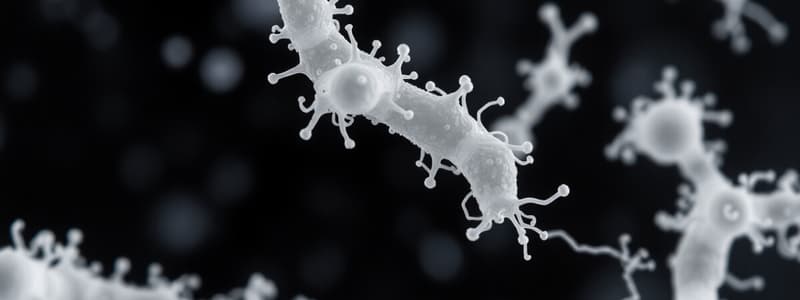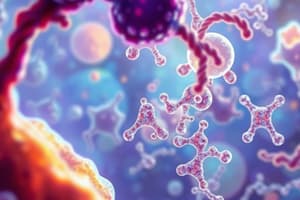Podcast
Questions and Answers
Which of the following methods is used to obtain pure cultures for accurate identification of microbes?
Which of the following methods is used to obtain pure cultures for accurate identification of microbes?
- High-temperature incubation
- Isolation media cultivation (correct)
- Molecular sequencing
- Antibiotic treatment
Biochemical tests utilize physical reactions to determine the presence of enzyme systems in bacteria.
Biochemical tests utilize physical reactions to determine the presence of enzyme systems in bacteria.
False (B)
Name one predominant biochemical test used in identifying bacteria.
Name one predominant biochemical test used in identifying bacteria.
Carbohydrate fermentation
What is the advantage of using genotype over phenotype in microbial identification?
What is the advantage of using genotype over phenotype in microbial identification?
Differential media is used to cultivate microorganisms without identifying specific characteristics.
Differential media is used to cultivate microorganisms without identifying specific characteristics.
Knowing an enzyme present in a specimen can often identify the ______ species.
Knowing an enzyme present in a specimen can often identify the ______ species.
Match each biochemical test with its function:
Match each biochemical test with its function:
List one method used for the direct identification of diseases.
List one method used for the direct identification of diseases.
A patient's blood is cultured in a special bottle of broth to identify pathogens, commonly referred to as _____.
A patient's blood is cultured in a special bottle of broth to identify pathogens, commonly referred to as _____.
Match the following conditions or methods with their identification approach:
Match the following conditions or methods with their identification approach:
What is the purpose of the Western blot test?
What is the purpose of the Western blot test?
The Western blot test can be used as a standalone test for HIV diagnosis.
The Western blot test can be used as a standalone test for HIV diagnosis.
What are the three types of lines that can form in a double diffusion test?
What are the three types of lines that can form in a double diffusion test?
In an agglutination reaction, antigens are __________ such as RBCs or bacteria.
In an agglutination reaction, antigens are __________ such as RBCs or bacteria.
Match the following terms with their definitions:
Match the following terms with their definitions:
What is the primary purpose of phage typing?
What is the primary purpose of phage typing?
Carbohydrate fermentation tests are conducted to identify bacterial susceptibility to antibiotics.
Carbohydrate fermentation tests are conducted to identify bacterial susceptibility to antibiotics.
What are the cleared areas on a Petri dish during phage typing indicative of?
What are the cleared areas on a Petri dish during phage typing indicative of?
The ________ involves mapping off a Petri dish into blocks for testing bacterial susceptibility to viruses.
The ________ involves mapping off a Petri dish into blocks for testing bacterial susceptibility to viruses.
Which of the following is not a component of the carbohydrate fermentation test?
Which of the following is not a component of the carbohydrate fermentation test?
What is the main purpose of Polymerase Chain Reaction (PCR)?
What is the main purpose of Polymerase Chain Reaction (PCR)?
Random Amplified Polymorphic DNA (RAPD) uses specific sequences of primers to identify known microbial populations.
Random Amplified Polymorphic DNA (RAPD) uses specific sequences of primers to identify known microbial populations.
What is the role of probes in hybridization techniques?
What is the role of probes in hybridization techniques?
In Fluorescent in situ Hybridization (FISH), probes are used to locate ______ cells in patient specimens.
In Fluorescent in situ Hybridization (FISH), probes are used to locate ______ cells in patient specimens.
Match the following genotypic techniques with their main applications:
Match the following genotypic techniques with their main applications:
Which genotypic technique is specifically used to confirm diagnoses or identify biofilm components?
Which genotypic technique is specifically used to confirm diagnoses or identify biofilm components?
Pulse-Field Gel Electrophoresis is a method used to amplify DNA in diagnostic tests.
Pulse-Field Gel Electrophoresis is a method used to amplify DNA in diagnostic tests.
Hybridization involves the use of ______ that are complementary to specific nucleic acid sequences from a microbe.
Hybridization involves the use of ______ that are complementary to specific nucleic acid sequences from a microbe.
What does the sensitivity of an immune test reflect?
What does the sensitivity of an immune test reflect?
Agglutination reactions involve soluble antigens.
Agglutination reactions involve soluble antigens.
What are the visual indicators used to observe antigen-antibody interactions?
What are the visual indicators used to observe antigen-antibody interactions?
In the RPR test, antibodies cause the ________ particles to agglutinate.
In the RPR test, antibodies cause the ________ particles to agglutinate.
Match the terms with their definitions:
Match the terms with their definitions:
Which characteristic distinguishes precipitation from agglutination?
Which characteristic distinguishes precipitation from agglutination?
What is the primary component of the 30s subunit of bacterial and archaeal ribosomes?
What is the primary component of the 30s subunit of bacterial and archaeal ribosomes?
Smaller antigen-antibody complexes can typically be observed with the naked eye.
Smaller antigen-antibody complexes can typically be observed with the naked eye.
What occurs when RPR antigen is mixed with plasma and antibodies are present?
What occurs when RPR antigen is mixed with plasma and antibodies are present?
Ribotyping is primarily used for identifying viruses.
Ribotyping is primarily used for identifying viruses.
Whole human or microbial cells form clumps with antibodies of the correct ________.
Whole human or microbial cells form clumps with antibodies of the correct ________.
What is the main purpose of serological testing?
What is the main purpose of serological testing?
In ribotyping, rRNA is ____ and analyzed from cultured cells.
In ribotyping, rRNA is ____ and analyzed from cultured cells.
What type of antigen is involved in precipitation reactions?
What type of antigen is involved in precipitation reactions?
Match the following substances with the types of materials that can be tested using modern serological methods:
Match the following substances with the types of materials that can be tested using modern serological methods:
Which of the following statements about antibodies is true?
Which of the following statements about antibodies is true?
Immunologic methods can only detect unknown antigens using known antibodies.
Immunologic methods can only detect unknown antigens using known antibodies.
What characteristic of a test ensures it only reacts with a specific antibody or antigen?
What characteristic of a test ensures it only reacts with a specific antibody or antigen?
Ribotyping is suited for bacterial identification and diagnosis of ____.
Ribotyping is suited for bacterial identification and diagnosis of ____.
Which of the following can be tested using modern serological methods?
Which of the following can be tested using modern serological methods?
Flashcards
Genus and species identification
Genus and species identification
The process of determining the specific type of microorganism or organism, using physical characteristics, biochemical reactions, immunological tests, and genetics.
Phenotypic identification
Phenotypic identification
Identifying organisms by their observable physical characteristics and functions, including their shape, behavior, and biochemical activities (enzymes).
Specimen collection
Specimen collection
Gathering a sample from a patient to find the microorganism causing an illness.
Microbial Identification Steps
Microbial Identification Steps
Signup and view all the flashcards
Differential media
Differential media
Signup and view all the flashcards
Salmonella/Shigella (SS) agar use
Salmonella/Shigella (SS) agar use
Signup and view all the flashcards
Specimen cultivation for microbe identification
Specimen cultivation for microbe identification
Signup and view all the flashcards
Biochemical tests purpose
Biochemical tests purpose
Signup and view all the flashcards
Carbohydrate fermentation test
Carbohydrate fermentation test
Signup and view all the flashcards
Biochemical test example
Biochemical test example
Signup and view all the flashcards
PCR
PCR
Signup and view all the flashcards
RAPD
RAPD
Signup and view all the flashcards
Hybridization
Hybridization
Signup and view all the flashcards
FISH
FISH
Signup and view all the flashcards
What does PCR stand for?
What does PCR stand for?
Signup and view all the flashcards
What's a probe in hybridization?
What's a probe in hybridization?
Signup and view all the flashcards
What does RAPD stand for?
What does RAPD stand for?
Signup and view all the flashcards
What is FISH used for?
What is FISH used for?
Signup and view all the flashcards
Phage typing
Phage typing
Signup and view all the flashcards
How phage typing works
How phage typing works
Signup and view all the flashcards
What does phage typing help identify?
What does phage typing help identify?
Signup and view all the flashcards
How are carbohydrates used in the test?
How are carbohydrates used in the test?
Signup and view all the flashcards
What information does the carbohydrate fermentation test provide?
What information does the carbohydrate fermentation test provide?
Signup and view all the flashcards
Sensitivity (immune testing)
Sensitivity (immune testing)
Signup and view all the flashcards
Visualizing antigen-antibody interactions
Visualizing antigen-antibody interactions
Signup and view all the flashcards
Agglutination
Agglutination
Signup and view all the flashcards
Precipitation
Precipitation
Signup and view all the flashcards
What's the key difference between Agglutination and Precipitation?
What's the key difference between Agglutination and Precipitation?
Signup and view all the flashcards
RAPID PLASMA REAGIN (RPR)
RAPID PLASMA REAGIN (RPR)
Signup and view all the flashcards
How does RPR work?
How does RPR work?
Signup and view all the flashcards
What happens in a positive RPR test?
What happens in a positive RPR test?
Signup and view all the flashcards
What happens in a negative RPR test?
What happens in a negative RPR test?
Signup and view all the flashcards
Importance of visualization in immune testing
Importance of visualization in immune testing
Signup and view all the flashcards
Ribotyping
Ribotyping
Signup and view all the flashcards
Serology
Serology
Signup and view all the flashcards
Antigen-Antibody Interaction
Antigen-Antibody Interaction
Signup and view all the flashcards
Specificity in Immune Testing
Specificity in Immune Testing
Signup and view all the flashcards
Unknown Antibody Detection
Unknown Antibody Detection
Signup and view all the flashcards
Unknown Antigen Detection
Unknown Antigen Detection
Signup and view all the flashcards
Urine, Cerebrospinal Fluid, Tissues & Saliva
Urine, Cerebrospinal Fluid, Tissues & Saliva
Signup and view all the flashcards
16s rRNA
16s rRNA
Signup and view all the flashcards
Ribosome
Ribosome
Signup and view all the flashcards
Conserved Sequence
Conserved Sequence
Signup and view all the flashcards
Western Blot for HIV
Western Blot for HIV
Signup and view all the flashcards
Double Diffusion (Ouchterlony)
Double Diffusion (Ouchterlony)
Signup and view all the flashcards
Line of Identity
Line of Identity
Signup and view all the flashcards



